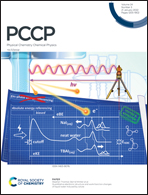Ammonia synthesis on BaTiO2.5H0.5: computational insights into the role of hydrides†
Abstract
Perovskite oxyhydrides such as BaTiO2.5H0.5 have been found to be able to catalyze NH3 synthesis, but the mechanism and the role of the catalyst's lattice hydrides in the catalytic reaction remain unknown. Here we employ first principles density functional theory to investigate the mechanism of ammonia synthesis and the role of lattice hydrides on a prototypical perovskite oxyhydride, BaTiO2.5H0.5 (BTOH). Two mechanistic hypotheses, the distal and alternating pathways, have been tested on the Ti2O2 termination of the BTOH (210) surface, previously determined to be the most stable surface termination under the reaction conditions considered. In the distal pathway, H atoms hydrogenate N2 to form the *N–NHx key intermediates, followed by N–N bond breaking. In the alternating pathway, H atoms hydrogenate N2 in an alternating fashion to form the *NHx–NHy intermediates before N–N bond breaking and formation of co-adsorbed *NHx/*NHy on the surface. We find that the subsurface hydride vacancy formed after reaction of *N2 with the lattice hydride is key to the distal pathway, leading to surface nitride formation after breaking the *N–NH3 bond, while the neighboring surface Ti sites are key to bridging and stabilizing the *NNH intermediate in the alternating pathway. In both pathways, desorption of NH3 is the most uphill in energy. Our results provide important insights into the role of hydrides and surface vacancies in hydrogenation reactions over BTOH, which will be useful to guide future spectroscopic experiments such as operando IR and inelastic neutron scattering to verify the key intermediates.



 Please wait while we load your content...
Please wait while we load your content...